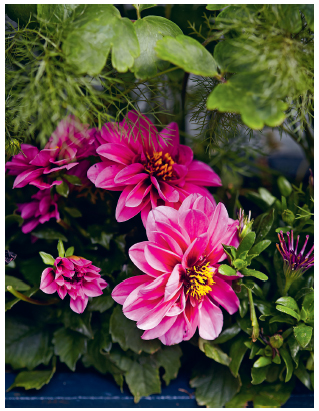Get the Look
What You Need
2 formal troughs, about 45–60 cm (18–24 in) long and 45 cm (18 in) deep
Deep blue gloss paint (I used Farrow & Ball Hague Blue)
Large paintbrush
Drainage crocks
Potting mix
Plants
2 ‘Purpureum’ bronze fennel (Foeniculum vulgare)
4 pink snapdragon (Antirrhinum)
2 ‘Rose Barlow’ columbine (Aquilegiavulgaris var Stellata)
2 ‘Lavella’ dahlia (Dahlia pinnata)
2 dark pink aster (Aster)
2 dark pink ‘Whirligig’ African daisy (Osteosperumum)
2 Sweetunia Series ‘Black Satin’ petunia (Petunia)

- Thoroughly clean the outside of the troughs (see Planting Techniques) first, as you want a nice, smooth surface for the gloss paint to adhere to. Give each trough two coats of paint, allowing the first coat to dry before applying the next. There is no need to paint inside the troughs – just the top part as the rest will be hidden by potting mix.
- Cover the base of the troughs with a few drainage crocks, then fill two-thirds full with potting mix.
- Start by planting the bronze fennel in the first trough, positioning it towards the back in the middle. Once you are sure the root ball is an inch or so below the rim of the trough, and added or removed potting mix as necessary, build up the display by planting the pink snapdragons on either side of the fennel.
- Next, plant the columbine behind the fennel and, again, check the root balls of all the plants are nice and level.
- Position the dahlia, with its bold pink flowers, in the middle of the trough, right at the front. This plant really needs to take centre stage.
- Continue adding the remainder of the plants, filling in any gaps and placing the smaller petunias at the front.
- Fill any gaps between the plants with more potting mix and firm in gently. Repeat for the other trough, trying to achieve as much symmetry as possible between the two planters.
- Water well and allow to drain.

Aftercare — Regularly deadheading the petunias and dahlias will encourage the plants to produce more flowers through the summer.
Tip — Remove the seed heads of columbine if you want to prevent them self-seeding in your garden or containers. Or perhaps save the seeds and have a go at propagating them for more plants the following year.



